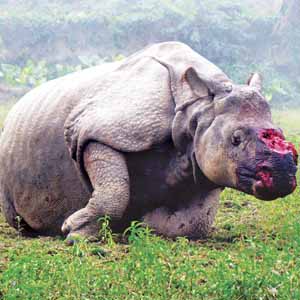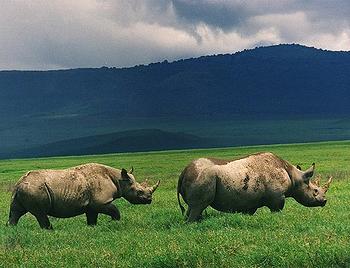最近公佈的保育研究顯示,有鑒于亞洲對犀牛角強烈需求的推動下,世界各地偷獵瀕臨滅絕動物的行爲,創下15年來新高。

一頭母犀牛於2009年1月慘遭盜獵者將其角硬生生採摘下後最終死亡。圖片來源不祥。
保育人士上週在日內瓦舉辦的(華盛頓公約)瀕絕野生動植物國際貿易公約(Convention on International Trade in Endangered Species,CITES)會議上向常設委員會表示,光2008年在南非和辛巴威就有至少162頭犀牛遭非法獵殺。而在2009年的前6個月則有62頭犀牛遭盜獵。
國際自然保育聯盟(IUCN)、全球保育組織世界自然基金會(WWF)、以及旗下的野生物監測網國際野生物貿易研究委員會(TRAFFIC)向該委員會表示,某些亞、非洲地區的偷獵者,在一個星期内盜捕多達2至3頭犀牛,以滿足日益增長的犀牛角需求。犀牛角以其藥用價值聞名。犀牛角含有類似頭髮濃縮角蛋白纖維的成份。
據保育人士的估計,相形之下,過去十年來的前五年,在所有非洲國家共計約18,000頭犀牛中,每個月只有3頭犀牛遭非法捕殺。
據簡報文件:「售往亞洲的非法犀牛角貿易是這波盜獵殺害潮的推手。有越來越多的證據顯示越南、中國、泰國國民 參與非法採購和將犀牛角自非洲運輸出境的活動」。
參與非法採購和將犀牛角自非洲運輸出境的活動」。
幾乎所有的犀牛物種都被列舉在CITES附錄一中。這意味著任何犀牛身上的部位,作爲商用性質的國際貿易都被視爲非法行爲。
但今年一個引人注目的獵殺行爲,震驚了印度社會並引發民衆對阿薩姆邦(Assam state)政府的抗議。 1月19日當天,在布拉馬普特拉(Brahmaputra)河南岸的聯合國教科文組織(UNESCO)世界遺產場址喀茲蘭加(Kaziranga)國家公園内,偷獵者挖出受傷母犀牛的角並殺害其3歲的小犀牛。盜獵者先對母犀牛開槍使其無法動彈,再取下它的角。接著受傷的犀牛於第二天終告死亡。後來,這張死去的母犀牛照片出現在報紙和電視上,引發了公眾對政府冷漠的反應一陣前所未有的撻伐。
此類情況在辛巴威最爲迫切,甚至嚴重到威脅過去十年來成功復育犀牛的工作成果。
迄今為止,只有5個締約國 -- 中國、德國、日本、紐西蘭、英國 -- 向CITES秘書處提交犀牛角庫存申報。該報告將輾轉移交到TRAFFIC。此外,沒有任何一個亞、非洲的犀牛產地國確實遵行這項決議。
參加第15屆CITES會議的締約國,將進一步討論有關犀牛偷獵和其生存的問題。該會議將于2010年3月13至25號在卡塔爾(Qatar)多哈市(Doha)舉行。
Driven by Asian demand for rhinoceros horns, worldwide poaching of these endangered animals is at a 15-year high, new conservation research reveals.
In South Africa and Zimbabwe alone, at least 162 rhinos were illegally killed in 2008 and another 62 have been poached during the first six months of 2009 conservationists told the Standing Committee of the Convention on International Trade in Endangered Species at a meeting last week in Geneva.The International Union for the Conservation of Nature, IUCN, and the global conservation organization WWF, and their affiliated wildlife trade monitoring network TRAFFIC told the committee that poachers in Africa and Asia are killing as many as two to three animals a week in some areas to meet a growing demand for horns, which are reputed to have medicinal value. Rhino horn is composed of compressed keratin fiber similar to hair.
By contrast, during the first five years of this decade, only three rhinos were illegally killed each month in all of Africa, out of a population of around 18,000, the conservationists estimated.
"Illegal rhino horn trade to destinations in Asia is driving the killing, with growing evidence of involvement of Vietnamese, Chinese and Thai nationals in the illegal procurement and transport of rhino horn out of Africa," according to the briefing document.
Almost all rhino species are listed in the Convention on Trade in Endangered Species Appendix I, which means that any international trade of any rhino parts for commercial purposes is illegal.
But one high-profile killing this year shocked the Indian public and sparked a protest against the government of Assam state. On January 19, in Kaziranga National Park, a UNESCO World Heritage Site on the south bank of River Brahmaputra, poachers gouged out the horn of an injured female rhino and killed her three-year-old calf. The poachers first fired upon the female rhino to immobilize her before taking the horn. The injured rhino died the next day. This picture of the dying female rhino appeared in newspapers and on TV, touching off an unprecedented public protest against the government's apathy.
The situation is particularly dire in Zimbabwe where such problems are threatening the success of more than a decade's work of bringing rhino populations back to healthy levels.
To date, only five Parties - China, Germany, Japan, New Zealand and the United Kingdom - have submitted rhinoceros horn stock declarations to the CITES Secretariat for transmission to TRAFFIC. No rhinoceros range States in either Africa or Asia have yet complied with this decision.
The issue of rhinoceros poaching and survival will be further discussed at the 15th meeting of the Conference of the Parties to CITES, which will be held in Doha, Qatar March 13-25, 2010.





